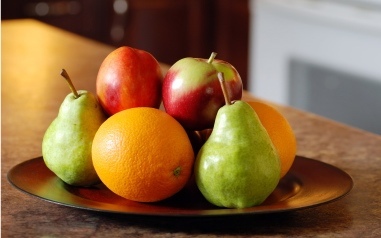Diophantine Equation - Ratio of Fruits
 The ratio of the number of apples to oranges to pears is 7:11:9.
The ratio of the number of apples to oranges to pears is 7:11:9.
Timmy ate 21 fruits.
As a result, the ratio of the number of apples to oranges to pears became 2:3:3.
How much fruit did he eat?
This section requires Javascript.
You are seeing this because something didn't load right. We suggest you, (a) try
refreshing the page, (b) enabling javascript if it is disabled on your browser and,
finally, (c)
loading the
non-javascript version of this page
. We're sorry about the hassle.
3 solutions
Discussions for this problem are now closed
Since we won't be dealing in fractions here, the total number of fruits to begin with (B) must be a multiple of 7+11+9 = 27 and after Timmy pigs out, a multiple of 8 (A). That is because 7, 11, and 9 have no common factors, nor do 2 and 3. Let B = 27 b and A = 8 a. 27b - 21 = 8a We need to solve this Diophantine Equation in integers. b = (8a + 21)/27 27 = 3 × 3 × 3, so 8a + 21 must be divisible by 3, 21 is a multiple of 3, so 8a must also be a multiple of 3. Therefore a must be a multiple of 3. Trying various multiples of 3, we find that the lowest value of a that makes this come out in integers is 21. (There are better ways of doing this, but in this case the slow method works because the numbers are small enough.) a = 21, means there were 168 fruits left (8a): 42 apples, 63 oranges, 63 pears (2a, 3a, 3a) adding the 21 fruits Timmy ate, makes 189 fruits 189/27 = 7, so b = 7 49 apples, 77 oranges, 63 pears. (7b, 11b, 9b) He ate 7 apples, 14 oranges, and 0 pears.
I noticed that all ratios were in their simplest form so all the fruit at that moment has to be a multiple of those ratios. (eg. There could've been 7 apples, 11 oranges and 9 pears; 14 apples, 22 oranges and 18 pears; ...) We can let these ratios be represented as vectors p and q where : p = ⎝ ⎛ 7 1 1 9 ⎠ ⎞ , q = ⎝ ⎛ 2 3 3 ⎠ ⎞ They represent the ratio of fruit before and after the eating respectively. We will also say that vector r is how much fruit was ate. The amount of fruit altogether can be given as ∣ a p ∣ and ∣ b q ∣ where a and b are integer constants. As ∣ p ∣ = 2 7 , ∣ q ∣ = 8 and the number of fruit ate was ∣ r ∣ , this gives us the Diophantine equation 2 7 a − 8 b = 2 1
Solving this Diophantine can be simple by taking both sides to the mod 27 giving − 8 b ≡ 2 1 m o d 2 7 ⟹ b ≡ 2 1 m o d 2 7
Note that − 8 b ≡ b m o d 2 7 is entirely coincidental.
Let b = 2 1 . This will give us a = 7 . A quick check will show that 7 × 2 7 − 2 1 × 8 = 2 1 . Hence 7 . ⎝ ⎛ 7 1 1 9 ⎠ ⎞ − 2 1 . ⎝ ⎛ 2 3 3 ⎠ ⎞ = ⎝ ⎛ 7 1 4 0 ⎠ ⎞
Giving us our final answer of 7 apples, 14 oranges and 0 pears.
According to the question, 27x-21=8y, where both x & y are positive integers. So, y=(3/8)(9x-7) For y to be integer, (9x-7) must be divisible by 8. When x=7, (9x-7) is divisible by 8, So y=21 Before eating, A=49, O=77, P=63 After eating, A=42, O=63, P=63 So 7 apples, 14 oranges & 0 pears have been eaten